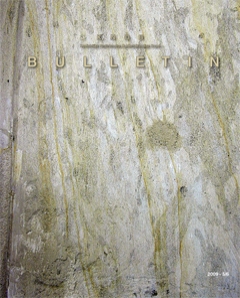Indexering ESCI / Scopus


Rob P.J. van Hees en Timo G. Nijland: Beoordeling van de staat van conservering van een Midden-Neolithische vuursteenmijn in Valkenburg aan de Geul. H.J. Tolboom en C.W. Dubelaar: Avendersteen in Nederland. Trudi Brink: Spiegel voor stadsbestuur nader onderzocht. Over de schouw van Colijn de Nole in Kampen. Wido Quist: Natuursteenvervanging aan de Grote of Maria-Magdalenakerk te Goes. Timo G. Nijland: Van Doornikse kalksteen tot beton 'als het definitieve materiaal'. Het materiaalgebruik van spoorwegarchitect H.G.J. Schelling.
Upper Cretaceous Maastricht limestone (locally denominated as ‘mergel’) outcrops in the provinces of Dutch and Belgian Limburg. The Upper Cretaceous in the Netherlands consists of the geological Maastricht Formation and the upper part of the Gulpen Formation. Limestone from the Maastricht Formation represents one of the few native Dutch types of natural stone used for building and construction. Locally, limestone from both formations contains considerable amounts of flint. This flint was mined in Neolithic times, both from the Lanaye limestone in the Gulpen Formation and the Emael...
Between the 15th and 19th centuries Avendersteen (Avesnes stone) was used for many sculptural works in the Netherlands. The stone, locally used as building material, was excavated in underground quarries near the village of Avesnes-le-Sec, in the north of France. That region was part of the Netherlands in the 15th and 16th centuries. Avendersteen was transported along the river Scheldt. That is why most of the Avendersteen can be found in the southern part of the Netherlands, but it appears that it was also used in Utrecht and even in Kampen. The use of Avendersteen seems to be connected...
The fireplace in the sheriffs’ courtroom of the old town hall in Kampen was made between 1543 and 1554 by the sculptor Colijn de Nole from the Southern Netherlands (living in Utrecht from 1530 onwards).
In order to learn more about the method of working of this sculptor the fireplace was subjected to a thorough research, focusing on type of stone, construction and paint. On the basis of research with an X-ray fluorescence apparatus it has been ascertained that the fireplace is composed of at least three types of stone: sandstone, Baumbergersteen and Avendersteen.
In the...
In this article the process of choice is examined leading to the application of specific types of natural stone as a replacement in restorations. For this purpose three consecutive restoration campaigns are analysed, which took place in the St Mary Magdalene church in Goes. The focus of attention is the question to what extent the architects involved took aspects of compatibility and sustainability into account in their choice. It appears that during the first two decades of the twentieth century the arguments of the choice were quite one-sidedly aimed at hardness, an assumed measure for...
Architect H.G.J. Schelling, originally a civil engineer, designed several railway stations in the Netherlands from the 1920s to 1950s. Schelling’s works show a distinct development in terms of construction materials used. Early railway stations, such as Naarden-Bussum (1926) have façades in fired clay brick, with details in Doornik limestone, as dimension stone typical of medieval building in the Netherlands. Later railway stations such as Amsterdam-Muiderpoort (1937) and Amsterdam Amstel (1939) were constructed in concrete, but fired clay brick, and in the case of Amstel railway station...


open access mogelijk gemaakt door Stichting OpenAccess
